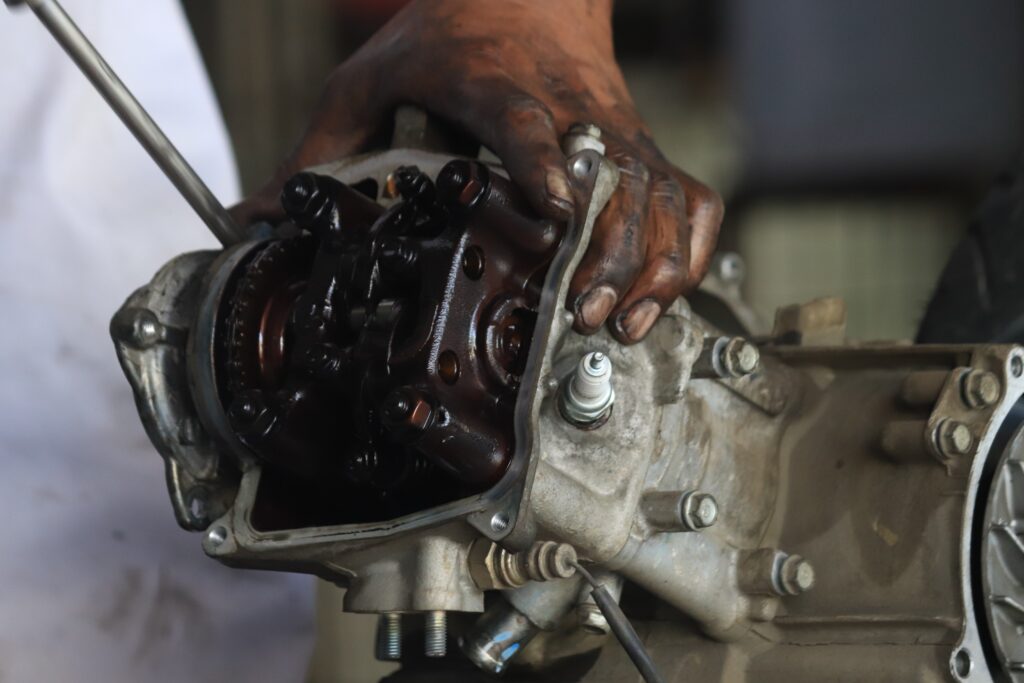If you’ve noticed that your car’s exhaust pipe is hanging low, you may be wondering how to fix it. Don’t worry, we’re here to help! In this article, we’ll provide you with some simple tips and tricks to get your exhaust pipe back in place and prevent any potential damage. Whether you’re a seasoned mechanic or a complete novice, our step-by-step guide will make it easy for you to tackle this issue on your own. Say goodbye to that dragging exhaust pipe and get ready to hit the road with confidence once again!
Recognizing the Problem
Signs of a loose exhaust pipe
If you notice that your exhaust pipe is no longer securely attached to your vehicle’s frame, it is a clear sign that the pipe is hanging low. This can be identified by visual inspection, where you may see the pipe hanging lower than usual or even dragging on the ground. Another indicator is an increase in noise, as the loose pipe can cause rattling or clunking sounds while driving.
Potential hazards if ignored
Ignoring a low hanging exhaust pipe can lead to several hazards. Firstly, there is a risk of the pipe detaching completely, causing it to fall onto the road and potentially causing accidents for both you and other drivers. Moreover, the dragging pipe may scrape against speed bumps or potholes, resulting in further damage to the exhaust system. In addition, a detached or damaged exhaust pipe can lead to harmful exhaust fumes entering the vehicle cabin, posing a danger to your health.
Benefits of immediate repair
Choosing to address a low hanging exhaust pipe promptly comes with various benefits. By repairing the issue, you ensure the safety of yourself and others on the road. Fixing the pipe also prevents any further damage to the exhaust system, which could be more expensive to repair in the long run. Additionally, resolving the problem will reduce noise pollution and improve the overall performance and fuel efficiency of your vehicle.
Understanding the Anatomy of an Exhaust Pipe
Primary components of an exhaust system
To understand how to fix a low hanging exhaust pipe, it’s important to familiarize yourself with the primary components of the exhaust system. These components include the exhaust manifold, which collects the exhaust gases from the engine cylinders, the catalytic converter, which reduces harmful emissions, and the muffler, which reduces noise. The exhaust pipe serves as the connecting pathway between these components and carries the exhaust gases from the engine to the rear of the vehicle.
Purpose of the exhaust pipe
The main function of the exhaust pipe is to redirect harmful exhaust gases away from the vehicle’s occupants. It also plays a crucial role in maintaining optimal engine performance by ensuring the proper flow of exhaust gases. Moreover, the exhaust pipe helps to minimize noise produced by the engine, as it carries the gases through various chambers and baffles in the muffler.
Placement and typical issues of exhaust pipe
The exhaust pipe is typically located underneath the vehicle, running from the exhaust manifold to the rear bumper. Due to its position, it is susceptible to various issues. One common problem is rust and corrosion, especially in areas with harsh weather conditions or exposure to road salt. Additionally, the exhaust pipe can become damaged from impacts, such as hitting speed bumps or debris on the road. Faulty or worn-out hangers, clamps, or brackets can also cause the pipe to hang low or detach completely.

Causes of a Low Hanging Exhaust Pipe
Rust and corrosion
Rust and corrosion are major culprits for a low hanging exhaust pipe. Over time, exposure to moisture, road salt, and other environmental elements can cause the metal of the exhaust pipe to corrode. This corrosion weakens the structural integrity of the pipe, making it prone to hanging low or separating from the vehicle’s frame. Regular inspection and maintenance can help identify any signs of rust or corrosion early on, allowing for timely repairs.
Damage from impact or harsh driving conditions
Driving over speed bumps, potholes, or rough roads can cause the exhaust pipe to hit the ground, leading to damage or misalignment. It is also possible for the pipe to be struck by debris on the road, especially if driving on unpaved or gravel roads. These impacts can cause the hangers or other components to break or become loose, resulting in a low hanging exhaust pipe.
Faulty or worn-out hangers, clamps, or brackets
The hangers, clamps, and brackets that secure the exhaust pipe to the vehicle’s frame can wear out over time. Constant exposure to heat, vibrations, and the elements can weaken these components, causing them to lose their grip on the pipe. When the hangers, clamps, or brackets fail, the pipe may hang low or detach completely. Regular inspection of these parts can help identify any signs of wear or damage, allowing for timely replacements.
Inspection of the Hanging Exhaust Pipe
Safety measures during inspection
Before inspecting the hanging exhaust pipe, it is crucial to prioritize safety. Ensure that your vehicle is parked on a flat surface and engage the parking brake. Allow the exhaust system to cool down to avoid burns. Use protective gloves and eyewear to protect yourself from any sharp edges or debris. If working underneath the vehicle, make sure to use jack stands or ramps to provide a stable and secure working environment.
Things to look out for: rust, damaged parts
During the inspection, carefully examine the entire length of the exhaust pipe for any signs of rust, corrosion, or physical damage. Pay close attention to areas where the pipe connects to the exhaust manifold, as well as the points where it is secured to the vehicle’s frame. Look out for any loose or broken hangers, clamps, or brackets that may be causing the pipe to hang low. If you notice any issues, it is recommended to address them promptly to prevent further damage.
Checking the exhaust pipe alignment and hang
Besides looking for visible signs of damage, it’s essential to check the alignment and hang of the exhaust pipe. The pipe should be parallel to the ground and evenly spaced from the undercarriage of the vehicle. If you notice that the pipe is sagging or hanging lower on one side, it could indicate a problem with the hangers or brackets. Ensure that the pipe is properly aligned and securely fastened to prevent dragging or detachment.

Tools Needed for Repair
List of necessary tools
To repair a low hanging exhaust pipe, you will need several tools. This includes a socket set with various sizes, a ratchet, a torque wrench, pliers, a hacksaw or reciprocating saw, and a rubber mallet or hammer. Additionally, you may require penetrating oil for loosening rusted bolts, a wire brush for cleaning, and a welding machine if you need to perform any welding repairs.
Sourcing the tools – buying or renting
If you do not already have the necessary tools, you have the option to either buy or rent them. If you anticipate frequent maintenance or repairs on your exhaust system in the future, it may be more cost-effective to purchase the tools outright. However, if you only require the tools for a one-time repair, renting them from a local hardware store or auto parts shop can be a more economical choice.
Safety gear and why it is important
When working on your vehicle’s exhaust system, it is imperative to prioritize safety by wearing appropriate safety gear. This includes gloves to protect your hands from heat, sharp edges, and debris, as well as eyewear to shield your eyes from any particles that may be dislodged during the repair process. Additionally, it is advisable to wear long sleeves and pants to protect your skin and closed-toe shoes for foot protection.
Fixing the Pipe: Reattaching the Hangers
Examining the hangers
Before reattaching the hangers, carefully inspect them for any signs of wear, damage, or breakage. Pay close attention to the rubber isolators, which can deteriorate over time. If any of the hangers or isolators appear to be damaged, it is recommended to replace them to ensure a secure attachment for the exhaust pipe.
Steps to reattach the hangers
To reattach the hangers, follow these steps:
- Lift the exhaust pipe and align it with the appropriate hangers on the vehicle’s frame.
- Ensure that the rubber isolators are properly positioned between the hangers and the exhaust pipe.
- Insert the hanger rods into the rubber isolators and secure them with the appropriate fasteners, such as bolts or nuts.
- Repeat the process for each hanger along the length of the exhaust pipe, ensuring that it is securely fastened.
Re-checking the pipe post re-attachment
After reattaching the hangers, it is crucial to re-check the alignment and hang of the exhaust pipe. Ensure that the pipe is parallel to the ground and evenly spaced from the undercarriage of the vehicle. Give the pipe a gentle tug to confirm that it is securely attached and does not move excessively. If the pipe still hangs low or appears misaligned, double-check the hangers and contact a professional if necessary.

Fixing the Pipe: Replacing Broken Parts
Identifying parts that need replacement
During the inspection, if you discover any broken or damaged components, it is essential to replace them to ensure the proper function and stability of the exhaust system. These parts may include hangers, clamps, brackets, or even sections of the exhaust pipe itself if it is severely corroded or beyond repair. Identifying the specific parts that need replacement will depend on the extent of the damage and the type of exhaust system your vehicle has.
How to correctly purchase replacements
To purchase the correct replacements, it is advisable to consult your vehicle’s manual or seek guidance from a professional mechanic or an auto parts specialist. They can help identify the exact parts and specifications that match your vehicle’s make, model, and year. Auto parts stores or online retailers specializing in exhaust systems can provide you with a range of options to choose from. Ensure that you select high-quality parts that are durable and compatible with your exhaust system.
Steps to replace the faulty components
If you need to replace any faulty components, follow these general steps:
- Begin by safely securing your vehicle on a level surface and engaging the parking brake.
- Use appropriate tools to loosen and remove the damaged components, such as hangers, clamps, or brackets.
- Install the new components, ensuring they are securely fastened and aligned correctly.
- Double-check the tightness of all fasteners and connections to prevent any potential leaks or loose fittings.
- Finally, reinspect the exhaust pipe alignment and hang to ensure that it is secure and in the correct position.
Preventive Measures to Avoid a Low Hanging Exhaust Pipe
Regular maintenance tips
To avoid a low hanging exhaust pipe, it is crucial to perform regular maintenance on your vehicle’s exhaust system. This includes periodic inspections to identify any signs of rust, corrosion, or damage. Additionally, keeping your vehicle clean, particularly the undercarriage, can help prevent the buildup of dirt, debris, or road salt that may contribute to corrosion. Regularly checking and tightening the hangers, clamps, and brackets can also help maintain a secure attachment.
Inspection frequencies
The frequency of inspection will depend on various factors, such as the age of your vehicle, driving conditions, and climate. As a general guideline, it is recommended to inspect your exhaust system at least once every six months or whenever you notice any unusual noises, vibrations, or changes in the exhaust pipe’s position. However, if you frequently drive in harsh conditions or have an older vehicle, more frequent inspections may be necessary.
Recommended products for exhaust pipe care
To care for your exhaust pipe and minimize the risk of corrosion, there are several recommended products available in the market. These include rust inhibitors or protective sprays specifically designed for exhaust systems. Regularly applying these products to the exposed surfaces of the exhaust pipe, especially during wet or winter months, can help prevent rust and extend the lifespan of the pipe. Consult with an auto parts specialist to identify the most suitable care products for your specific exhaust system.
In conclusion, a low hanging exhaust pipe is a problem that should not be ignored. By recognizing the signs, understanding the anatomy of the exhaust pipe, and identifying the causes, you can take the necessary steps to fix the issue and prevent further hazards. Regular inspection, timely repairs, and proper maintenance are essential for ensuring the optimal performance, safety, and longevity of your vehicle’s exhaust system. Remember to prioritize safety, use the necessary tools and safety gear, and seek professional assistance when needed. By taking these preventive measures, you can keep your exhaust pipe securely attached and your vehicle running smoothly for miles to come.
